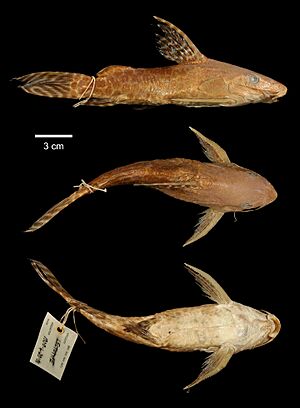Synodontis pardalis facts for kids
Quick facts for kids Synodontis pardalis |
|
|---|---|
 |
|
| Conservation status | |
| Scientific classification | |
| Genus: |
Synodontis
|
| Species: |
pardalis
|
Synodontis pardalis is a cool type of upside-down catfish. It's special because it's only found in Cameroon, a country in Africa. Specifically, it lives in the Dja River and its connected waters. This fish got its name, pardalis, from a Greek word meaning "leopard." This is because it has spots just like a leopard! A scientist named George Albert Boulenger first described this fish in 1908.
What Does the Leopard Catfish Look Like?
Like other Synodontis fish, the S. pardalis has a strong, bony head. This head bone goes all the way back to its first top fin spine. It also has a special bony bump on its shoulder area called a humeral process. The shape of this bump helps scientists tell different Synodontis species apart. For S. pardalis, this bump is a bit rough and slightly longer than it is wide.
This catfish has three pairs of barbels, which are like whiskers. One pair is on its upper jaw, and two pairs are on its lower jaw. The upper jaw barbels are long and straight. They can be as long as or a little shorter than the fish's head. The outer pair of lower jaw barbels is almost twice as long as the inner pair. These barbels have small branches on them.
The front edges of the top fin (dorsal fin) and the side fins (pectoral fins) of Synodontis fish are hard spines. The spine on the top fin of S. pardalis is about as long as its head. It's slightly curved and smooth on the front, but it has a saw-like edge on the back. The rest of the top fin has seven soft rays. The side fin spines have saw-like edges on both sides.
The small, fleshy fin near the tail (adipose fin) is three to four times longer than it is deep. The fin on its belly (anal fin) has four unbranched rays and seven branched rays. The tail fin is deeply split and shaped like a crescent moon.
All Synodontis fish have a special patch of teeth on the front of their upper jaw. This patch has several rows of short, chisel-shaped teeth. In S. pardalis, this tooth patch is short and wide. On its lower jaw, the teeth are attached to flexible, stalk-like parts. These teeth are often described as "s-shaped" or "hooked." The number of teeth on the lower jaw helps identify the species. S. pardalis usually has about 15 to 20 teeth on its lower jaw.
The main color of the fish's body is light brown. It gets lighter towards its belly. Its head has many small, round, dark brown spots. The rest of its body has larger round dark brown spots. The light brown color between these spots forms a network pattern.
The fins are white with horizontal black stripes. The top fin has 5 to 7 stripes. The belly and anal fins have 3 or 4 stripes each. The tail fin has 7 to 11 stripes.
This fish can grow up to about 23.5 centimetres (9.3 in) long. Generally, female Synodontis fish tend to be a bit larger than males of the same age.
Where Does the Leopard Catfish Live?
In the wild, the Synodontis pardalis has only been found in the Dja River and one of its smaller rivers, the Libi River. Both are part of the Central Congo River basin.
The places where this fish lives are facing some challenges. For example, cobalt mining activities on the Dja River can affect its home. People also sometimes catch these fish for food.
Reproduction and Life Cycle
Scientists don't know much about how most Synodontis species reproduce. They have found eggs in some female fish, which gives them clues. It's thought that these fish likely lay their eggs during the rainy season, which is usually between July and October. During this time, pairs of fish might swim together when they lay eggs.
Young Synodontis pardalis fish grow quickly during their first year. After that, their growth slows down as they get older.


